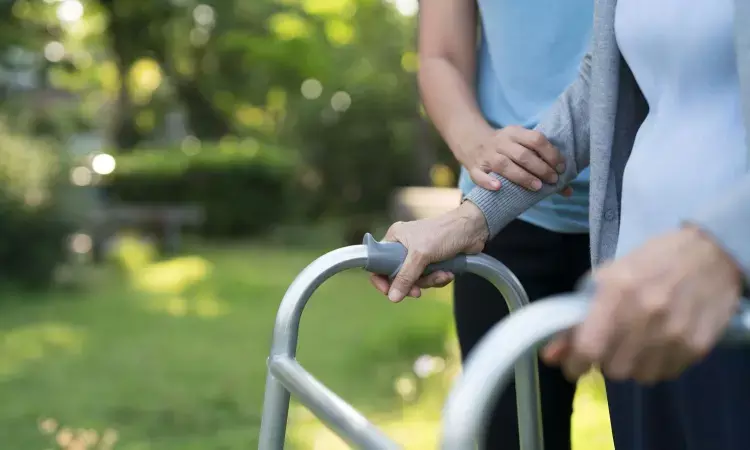- Home
- Medical news & Guidelines
- Anesthesiology
- Cardiology and CTVS
- Critical Care
- Dentistry
- Dermatology
- Diabetes and Endocrinology
- ENT
- Gastroenterology
- Medicine
- Nephrology
- Neurology
- Obstretics-Gynaecology
- Oncology
- Ophthalmology
- Orthopaedics
- Pediatrics-Neonatology
- Psychiatry
- Pulmonology
- Radiology
- Surgery
- Urology
- Laboratory Medicine
- Diet
- Nursing
- Paramedical
- Physiotherapy
- Health news
- Fact Check
- Bone Health Fact Check
- Brain Health Fact Check
- Cancer Related Fact Check
- Child Care Fact Check
- Dental and oral health fact check
- Diabetes and metabolic health fact check
- Diet and Nutrition Fact Check
- Eye and ENT Care Fact Check
- Fitness fact check
- Gut health fact check
- Heart health fact check
- Kidney health fact check
- Medical education fact check
- Men's health fact check
- Respiratory fact check
- Skin and hair care fact check
- Vaccine and Immunization fact check
- Women's health fact check
- AYUSH
- State News
- Andaman and Nicobar Islands
- Andhra Pradesh
- Arunachal Pradesh
- Assam
- Bihar
- Chandigarh
- Chattisgarh
- Dadra and Nagar Haveli
- Daman and Diu
- Delhi
- Goa
- Gujarat
- Haryana
- Himachal Pradesh
- Jammu & Kashmir
- Jharkhand
- Karnataka
- Kerala
- Ladakh
- Lakshadweep
- Madhya Pradesh
- Maharashtra
- Manipur
- Meghalaya
- Mizoram
- Nagaland
- Odisha
- Puducherry
- Punjab
- Rajasthan
- Sikkim
- Tamil Nadu
- Telangana
- Tripura
- Uttar Pradesh
- Uttrakhand
- West Bengal
- Medical Education
- Industry
Vitamin D may improve spine trabecular bone score and gait speed in older women

USA: A recent study published in the journal Bone has revealed that vitamin D level is associated with mobility performance and bone microarchitecture in older women who are residents of long-term care (LTC) facilities.
"25OHD was associated with gait speed and spine trabecular bone score (TBS) in older women residing in LTC facilities," Nami Safai Haeri, University of Pittsburgh, Pittsburgh, PA, USA, and colleagues reported. " The strengths of the associations indicate there may be other factors with a more prominent role in bone microarchitecture, physical function, and muscle strength in this population."
Sarcopenia and osteoporosis are major public health issues in older adults. There is compelling evidence that sarcopenia and osteoporosis often coexist, and their synergic effect leads to increased morbidity, significant functional impairment, and socioeconomic burden.
Sarcopenia is defined as the progressive loss of skeletal muscle strength, function, and mass. Osteoporosis is characterized by degraded bone microarchitecture and low BMD (bone mineral density) with a consequent increase in fragility fractures.
Trabecular bone score (TBS) is a novel method for the evaluation of bone microarchitecture, whereas gait speed and grip strength are simple methods for assessing muscle function and strength. Few studies have linked the relationship between vitamin D levels (25OHD) with TBS, gait speed, and grip strength in healthy community-dwelling adults.
Against the above background, the researchers sought to investigate this relationship in older women with osteoporosis and multiple comorbid conditions residing in long-term care facilities.
For this purpose, they analyzed baseline 25OHD, grip strength, spine TBS, and gait speed among 246 women with osteoporosis who were LTC residents and enrolled in a randomized controlled clinical trial.
Following were the study’s key findings:
- On average, participants were 81.6 years old and had a BMI of 26.8 kg/m2.
- The correlation (r) of 25OHD with spine TBS, grip strength, and gait speed were (r = 0.15), (r = − 0.05), and (r = 0.19), respectively.
- Each 5 ng/dl increase in 25OHD was associated with an increase of 0.006 in spine TBS and 0.014 m/s in gait speed.
- After adjusting for covariates, each 5 ng/dl increase in 25OHD was associated with an increase of 0.004 in spine TBS and 0.012 m/s in gait speed.
"Our results indicate a significant association between 25OHD with spine TBS, a significant association between 25OHD and gait speed, and no evidence of an association between vitamin D and grip strength in this population," the researchers wrote.
"The findings persisted following adjustment for potential confounders including age, spine BMD, BMI, renal function, serum calcium level, and history of cancer, smoking, fracture, and alcohol consumption."
Reference:
Haeri, N. S., Perera, S., & Greenspan, S. L. (2023). The association of vitamin D with bone microarchitecture, muscle strength, and mobility performance in older women in long-term care. Bone, 116867. https://doi.org/10.1016/j.bone.2023.116867
Dr Kamal Kant Kohli-MBBS, DTCD- a chest specialist with more than 30 years of practice and a flair for writing clinical articles, Dr Kamal Kant Kohli joined Medical Dialogues as a Chief Editor of Medical News. Besides writing articles, as an editor, he proofreads and verifies all the medical content published on Medical Dialogues including those coming from journals, studies,medical conferences,guidelines etc. Email: drkohli@medicaldialogues.in. Contact no. 011-43720751


